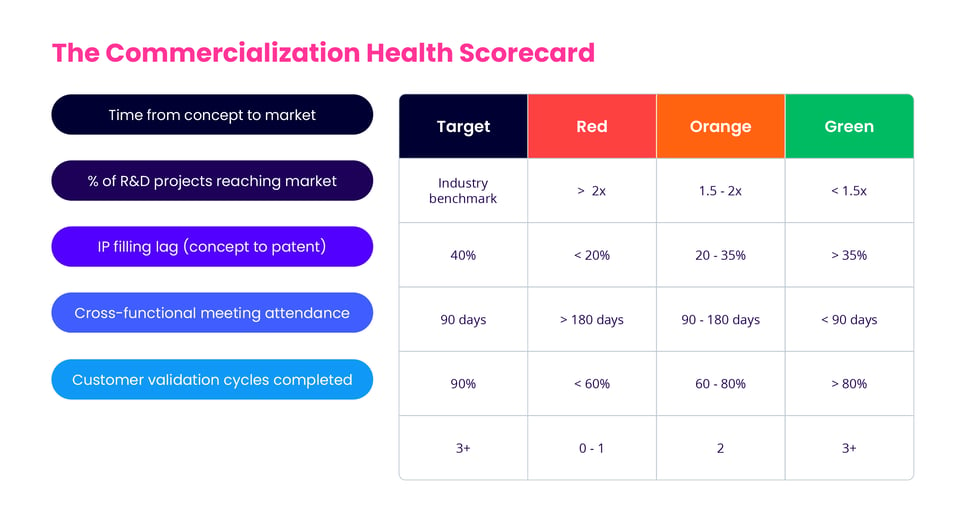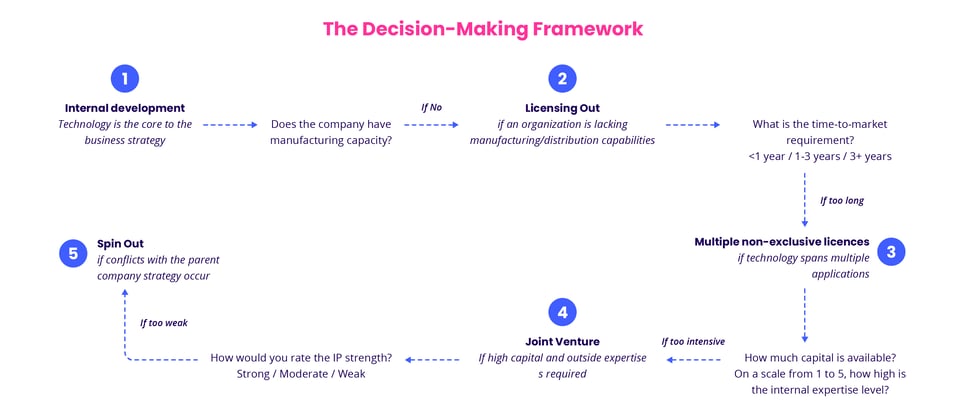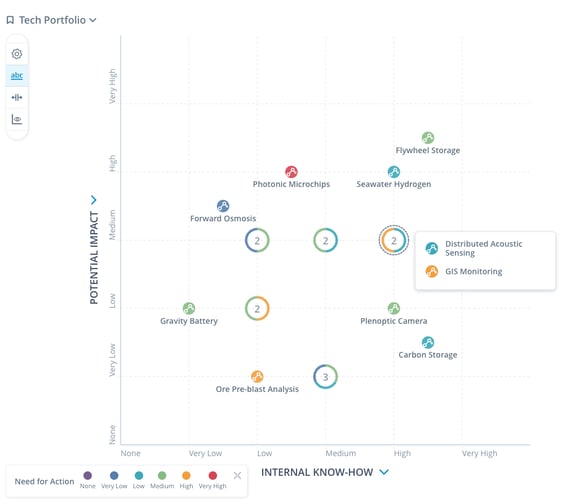An R&D team just spent 2.3 million and 18 months developing a breakthrough technology. The patents are filed. The prototype works flawlessly. The team is celebrating.
And it will never make a dollar.
Around the world, countless technologies remain stuck in R&D labs, unable to reach the market: please don’t join the graveyard. Across industries, an estimated $1 trillion in R&D spending sits trapped in labs, warehouses, and patent portfolios: technologies that work perfectly but will never reach a customer. Not because science failed, but commercialization did.
In an increasingly competitive landscape, long-term growth and industry leadership need to prioritize commercialization. Let’s explore the strategies that make this process successful.
What good is a breakthrough technology if it never sees the light of day?
Despite the high potential of new technologies, many fail to reach consumers or businesses due to inadequate strategies for commercialization. Whether it’s an emerging biotech solution, a disruptive energy technology, or a next-gen software platform, turning an idea into a viable product or service requires more than just technical expertise.
Here’s what makes commercialization fail: It’s not one catastrophic mistake. It’s seven silent killers working in combination. Finance won’t fund it. Sales can’t sell it. Manufacturing can’t build it profitably. And by the time everyone aligns, the market window has closed.
The question isn’t whether your technology works. It’s whether you can get it to market before you run out of cash, patience, or competitive advantage. Therefore, the following seven strategies can help to accelerate technology commercialization.
1. Involve all departments to connect the dots
Commercializing a technology requires collaboration. Yet many companies still operate in silos, lacking a single source of truth that connects teams. The result: R&D might, for instance, develop a technology that fails to align to gain traction with marketing and sales because it doesn’t align with their vision and goals, or even workflows.
As Prof. Andy Wynn shared in a podcast with ITONICS, bringing innovation to market means interacting with a vast network: operations, finance, legal, marketing, suppliers, investors, and even local government. Each stakeholder holds a piece of the commercialization puzzle.
If your job is taking innovation to market, then you’re going to need to interact with all sorts of people: the operations manager, the sales manager, the marketing director, the finance guy, legal, CEO, CTO, etc. Depending on the nature of your role, you might be working with investors or with external suppliers, customers, or even local government if you’re going to build a factory. Now, that’s a huge amount of people, all with different objectives, and all of them have a role in making your project a success or not.
Often, innovations are not just the physical products themselves but involve a new business model, which will likely require a major shift for departments in your company. In the following case, a medium-sized manufacturing company wanted to launch a digital subscription model for its products. This move demands a complete mindset shift across departments: from sales to customer service. Without shared understanding and commitment, commercialization collapses. Consulting agreements and shared tools clarify responsibilities and keep everyone aligned.
A study by McKinsey found that 58% of top-performing innovators excel at cross-functional collaboration, enabling them to launch faster and outperform peers. Such an agile collaborative approach requires a software solution where insights and opinions from different teams can be integrated from the onset of the innovation process all the way through to market launch.
Getting input from various departments can’t just be an afterthought. It’s an essential part of the innovation process that increases the chances of successful commercialization.
2. Understand and manage the commercialization process from research to market
Leaders in technology commercialization treat technology as a highly structured and measurable process, similar to the principles of improving manufacturing quality. They set measurable goals for ongoing improvement, develop the necessary organizational skills, and encourage teams to take bold action.
If a commercialization process lacks visibility, organizations risk delays and wasted resources. Companies can tame this complexity with digital tools that connect projects, milestones, and departments.
Exhibit 1: Project dashboards to track an entire project landscape
Visualize technology projects on the Roadmap, connect dependencies, align efforts of all the departments involved, and mark key milestones towards commercialization.
/Still%20images/portfolio-link-projects-teams-and-milestones-2025.webp?width=2160&height=1350&name=portfolio-link-projects-teams-and-milestones-2025.webp)
Exhibit 2: Shared roadmap to link projects, teams, and milestones
Measuring commercialization performance is essential. With the help of a pre-defined commercialization health scorecard (Exhibit 3), organizations can assess their performance with an easy-to-use scheme. By tracking the process monthly, commercialization needs to be halted and diagnosed once 2+ metrics are red.

Exhibit 3: The commercialization health scorecard
Using an innovation project’s success rate is essential to assess which technologies reach the market. With the analysis of results by technology area or market segments, or tracking relevant metrics, data-driven approaches help companies refine investment and seize time-sensitive opportunities such as patent filings.
3. Protect intellectual property with a strong patent strategy
Protecting intellectual property is the foundation of successful technology commercialization. Patents, trademarks, and copyrights safeguard innovations, but choosing the right form depends on the technology and market strategy.
Engaging a patent attorney early helps navigate application complexities, manage office actions, and secure protection in international markets. Especially important since early disclosure can forfeit rights in some jurisdictions.
Take the example of a biotech startup developing a new drug delivery system. The organization had six months of runway and faced a critical decision: file a provisional patent for $5,000 or wait to file a full utility patent costing over $15,000. The marketing team wanted to present the innovation at an upcoming conference in three months, but public disclosure risked losing patent rights.
A patent attorney conducted a freedom-to-operate analysis:
Outcome: three overlapping patents, similar delivery mechanisms
Conclusion: filing a provisional patent to secure an early filing date while refining their claims
Within four months, the company raised $2 million in Series A funding, with investors citing the patent-pending status as key to their confidence. The startup later converted the provisional patent into a full patent and licensed the technology to a larger pharmaceutical company.
The lesson for the startup: filing early protected the company’s innovation and accelerated investment. Demonstrating how strategic IP management directly supports commercialization.
Thus, a well-managed IP portfolio secures new technologies, accelerates technology transfer, and increases licensing potential. By protecting intellectual property strategically, organizations can maximize the commercial value of their technologies and lay a solid foundation for growth.
Technology transfer bridges the gap between research and market application. Whether you’re part of a university, a startup company, or an existing company, choosing the right path – licensing agreements, joint ventures, or spin-outs – determines how fast and effectively you scale (Exhibit 4).

Exhibit 4: The decision-making framework
Licensing agreements remain one of the most flexible mechanisms for commercialization. They enable research institutions and companies to collaborate while sharing revenue and risk. Cooperative research arrangements and joint development programs further extend technology capacity and industry reach.
Strong partnerships and transparent communication are key. Each stakeholder brings unique resources, like funding, facilities, or regulatory expertise. Aligning expectations through clear licensing and collaboration agreements prevents friction and accelerates progress. Technology transfer, done right, shortens commercialization timelines and amplifies impact.
4. Bridge research commercialization with market validation
Too often, innovators get lost in the technical details of how a technology works instead of focusing on what it does for users. Successful commercialization depends on connecting research outcomes with real market needs.
Communicate value simply. Highlight how the technology solves a problem, who benefits, and why it matters. Use pilot projects and early customer feedback to validate assumptions and prove demand.
In an example of an R&D team, they developed a breakthrough technology for reducing energy consumption in industrial equipment. While the technology may work perfectly in the lab, the team must bridge that gap by validating it with real-world applications. Market validation means testing it with early adopters, obtaining feedback on performance, and demonstrating clear, quantifiable benefits. Such as how much energy it saves and how much money it can save companies.
Collaboration remains crucial at this stage. Gain support from internal champions and external partners alike. Whether partnering with an existing company to enter a new market or licensing technology to a startup company for faster execution, shared ownership accelerates adoption. In the previous case, the research team could partner with a leading industrial equipment manufacturer to pilot the technology, ensuring it meets both technical and business needs.
Market validation bridges invention and value creation: the heart of research commercialization.
5. Build an ecosystem connecting startups, corporates, and researchers
Technology commercialization thrives when organizations leverage a strong ecosystem. Startups, corporates, research institutions, investors, and government bodies: all play vital roles. Successful collaboration across these groups drives faster market entry and ensures technologies reach their full potential.
Effective relationship management is the backbone of this ecosystem. Regular communication, shared KPIs, and transparency help maintain alignment throughout the commercialization process. Whether partnering with a startup for speed or a corporate giant for resources, strong partnerships align innovation efforts with market readiness.
A common challenge is misalignment between ideas and company capabilities. Many organizations launch ideation challenges, but few ideas reach commercialization. To avoid this, ensure that innovations align with internal strengths and market needs.
For example, pursuing a moonshot technology requires evaluating internal capabilities against potential impact. ITONICS Matrix (Exhibit 5) helps assess technologies, identifying where expertise is missing and guiding capability development before scaling.
By integrating capability-building with ecosystem partnerships, organizations ensure their commercialization efforts are grounded in readiness. Whether forming spin-outs, launching a startup, or partnering with corporates, internal alignment is key to success.
Technology commercialization is not just about the technology. It’s about aligning people, structure, and timing to turn ideas into lasting market success.

Exhibit 5: The ITONICS Matrix
6. Validate customer willingness to pay before building anything
Commercialization isn’t about what’s technically possible, it’s about what customers will actually buy. Too often, teams fall in love with their technology and start building before confirming real demand. The result: months of wasted effort developing products that no one values enough to purchase.
Out of our experience, we can say that before writing specifications or committing major resources, every organization should talk to at least 10 potential customers. Don’t ask if they like the idea: ask if they’d pay for it, at what price, and when. Simple validation experiments can reveal a lot: a landing page test with targeted ads can measure genuine interest even before a product exists, while a price sensitivity analysis helps identify what the market will bear.
Set clear validation milestones. For example, require three letters of intent from real customers before moving beyond feasibility. Use a minimum viable product (MVP) to test the core value proposition and not every feature. And avoid the classic pitfall of equating market size with opportunity. A $5 billion market means nothing if customers aren’t willing to buy your version of the solution.
Teams that validate willingness to pay early save six to twelve months of development time and focus R&D resources on technologies with true commercial potential.
7. Establish clear go/kill decision gates to focus on what works
Many promising technologies stall because teams struggle to make clear decisions about which projects to advance and which to stop. Thus, projects drift forward without proof of progress, consuming time and talent that could be better used elsewhere. Setting clear go/kill gates keeps innovation focused and evidence-driven.
Define four to six checkpoints – from concept and feasibility to development, pilot, launch, and scale – where each project is assessed against simple, objective criteria:
Is the technology technically sound?
Do customers show interest? Is the solution scalable and aligned with the strategy?
In addition, clear timelines (Exhibit 6) can be helpful to focus on clear decisions. With the help of the playbook timeline, the first conclusions can be drawn, what exactly needs to be done to manage commercialization successfully.
Exhibit 6: The commercialization playbook timeline
Assign a single accountable decision owner to ensure consistency and speed. If a project repeatedly fails to meet its criteria, it should be paused, re-scoped, or stopped. This approach builds a culture of learning, clarity, and momentum, helping teams channel energy toward the innovations most likely to succeed.
When is commercialization a priority? And when not?
The final tip sounds so obvious that it doesn’t seem worth stating: make commercialization an explicit priority. Companies that just pay lip service to technology face the consequences when their competitors eventually outpace them.
Industry leaders put commercializing technology high on the corporate agenda. Innovation is not a task to be relegated to a corner of the R&D lab. Turning technologies into viable products and services requires collaboration, diverse skill sets, and cross-departmental buy-in.
There are multiple pathways to successful commercialization, including forming spin outs, a new company, a startup company, or startups to bring inventions to market. But there are cases when the strategies cannot be applied successfully:
When technologies require deep integration with existing products.
When unique manufacturing capacities outdo competitors.
When the market window is narrow (< 18 months) and licensing negotiations take time.
Ultimately, technology commercialization is both: creating breakthroughs and making it a deliberate, company-wide priority. By aligning people, processes, and strategy, organizations can turn promising technologies into real market impact and sustained growth.
From research to market: manage your commercialization journey with ITONICS
Those who treat commercialization as a core discipline will lead the next wave of innovations. Thus, commercialization succeeds when ideas, data, and people work in sync. The ITONICS Innovation OS helps organizations do exactly that: bring strategy, research, and execution together on one platform. Use the ITONICS Portfolio to track commercialization progress, align resources, and manage risk.
Explore ITONICS Roadmap to map dependencies, milestones, and IP lifecycles.
And rely on ITONICS Insights and ITONICS Radar to monitor market trends, spot partnership opportunities, and guide technology transfer decisions.
The result: faster, smarter commercialization built on evidence, collaboration, and transparency.
Discover how ITONICS Innovation OS can help your organization turn research into market success.




